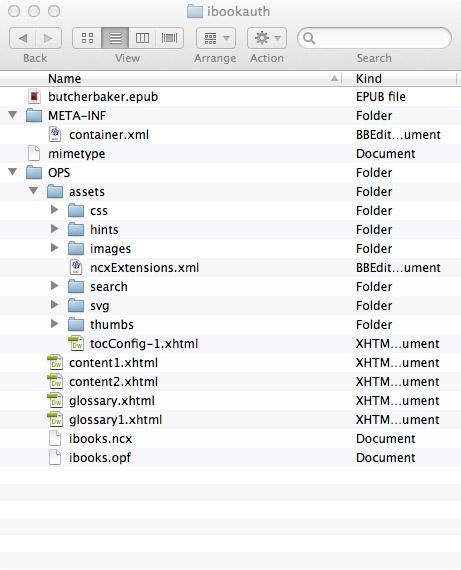Amazon recently announced KF8, which adds HTML5 interactivity to ebooks sold on the Kindle Fire (and later other Kindles). In a counterpunch, Apple recently announced the Apple iBooks format (.iba), which adds new levels of interactivity to ebooks produced for Apple’s iBookstore.
It’s not like they’ve abandoned their previous formats, however. They’ve simply added new ones. New ones that are… somewhat proprietary. I say somewhat, because the epub format is at the core of both. I can start with an epub formatted ebook, for example, and use KF8 to generate an Amazon-valid eBook in the .mobi format. An unzipped Apple iBook Author document (.iba) looks like this, with an epub sitting in the middle of the thing, big as life.
[Hint: to get this result, one must Export from iBooks Author, then change the .ibooks extension to .epub. From there, you can unzip the file.]

There’s been a bit of back and forth between Daniel Glazman, co-chair of the W3C CSS Working Group, and John Gruber, of Daring Fireball, as to whether the new Apple format is a helpful development. (I hope they get to Amazon’s KF8, as well. Because, as I said elsewhere, this is a salvo in the eBook Store battle between Amazon and Apple.)
I think both writers have valid points. As Gruber notes, Apple has created a tool that adds considerable value to its own platform. The output, to say the least, is not only gorgeous but truly interactive. It takes eBooks to the next level. And iBooks Author is Apple-easy to use, of course. But there is one point that Glazman makes about the iBooks Author format that sticks the hardest:
[T]his is a bad strategy because publishers are fed up with formats. For one book, they have too many formats to export to. For each format, they have to use tools to convert (usually from MS Word) that are incomplete and all require manual reformatting or validation. Adding an extra format that is almost EPUB3 but is definitely not EPUB3 output by a software that is an isolated island and does not offer any extra help to reduce the publishing burden is representing a huge extra investment…
Yes, of course this format proliferation isn’t Apple’s fault per se. And, yes, Amazon is doing the same thing (neener, neener, children on a playground, anyone?). But a quick perusal of the Wiki page on eBook formats reveals… 17 different versions, twelve of which are still active. No, wait… Add KF8 and IBA and that makes fourteen… This is definitely the “worse” part of the format war. You will have to create multiple versions of your eBook if you want to sell everywhere.
And remember, too, that Apple considers the Multi-Touch books created by iBook Author as separate entities, requiring an additional contract (Source: iBookstore: Publisher User Guide 2.0, January 19, 2012). So even Apple acknowledges there’s extra work here.
The “better” part? Standards are definitely starting to coalesce around the epub format. The Kindle Fire, for example, is said to support epub as well as mobi. Indeed, epub is the most widely supported “vendor-independent XML-based e-book format,” with a wide variety of platforms supported, from iOS, to Barnes & Noble’s Nook, to the Sony Reader, to a bunch of others.
Overall, though, I would say this is like chemotherapy. It’s supposed to make things better, but right now it really feels bad.
2 thoughts on “eBook Chemotherapy”